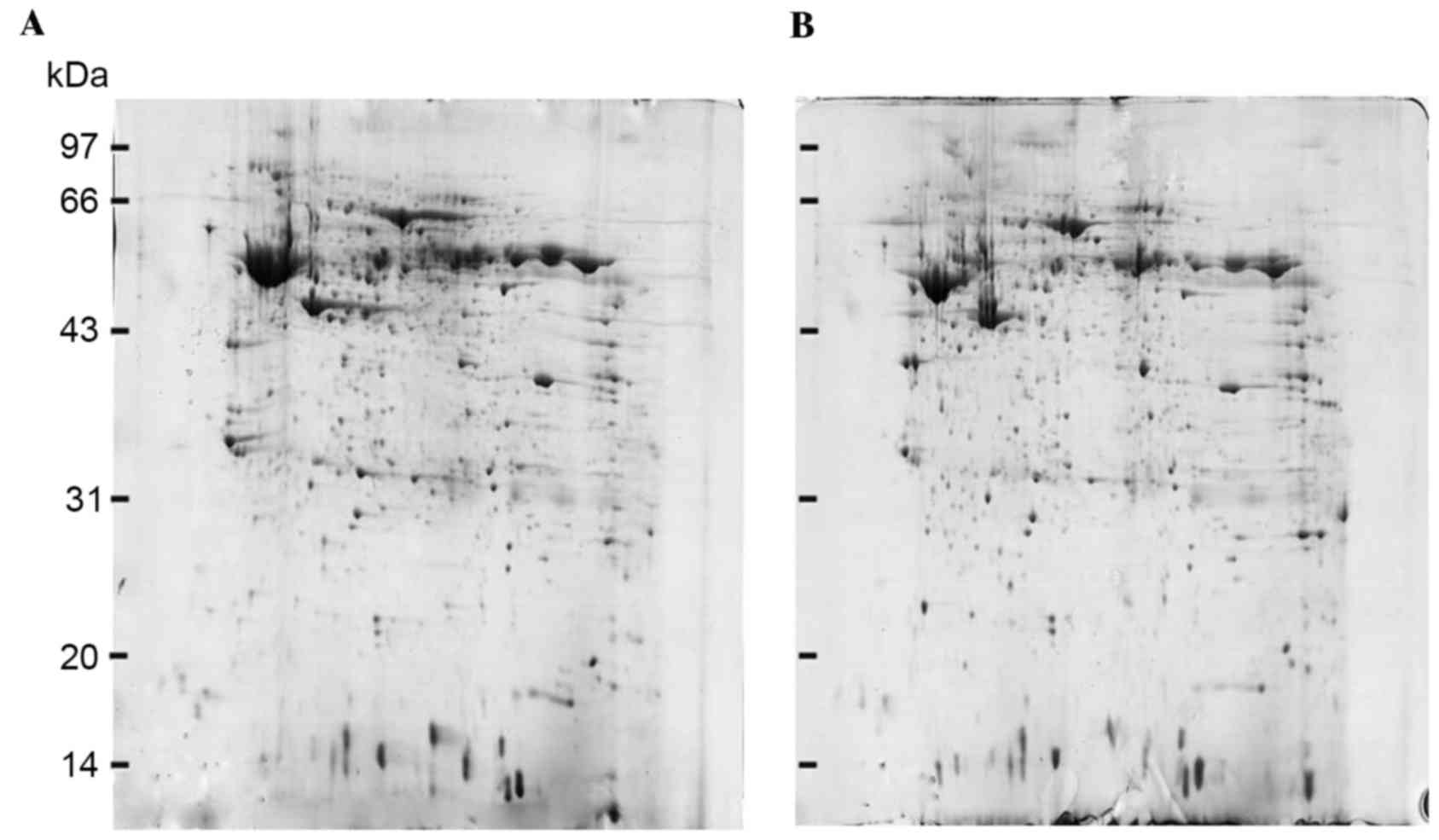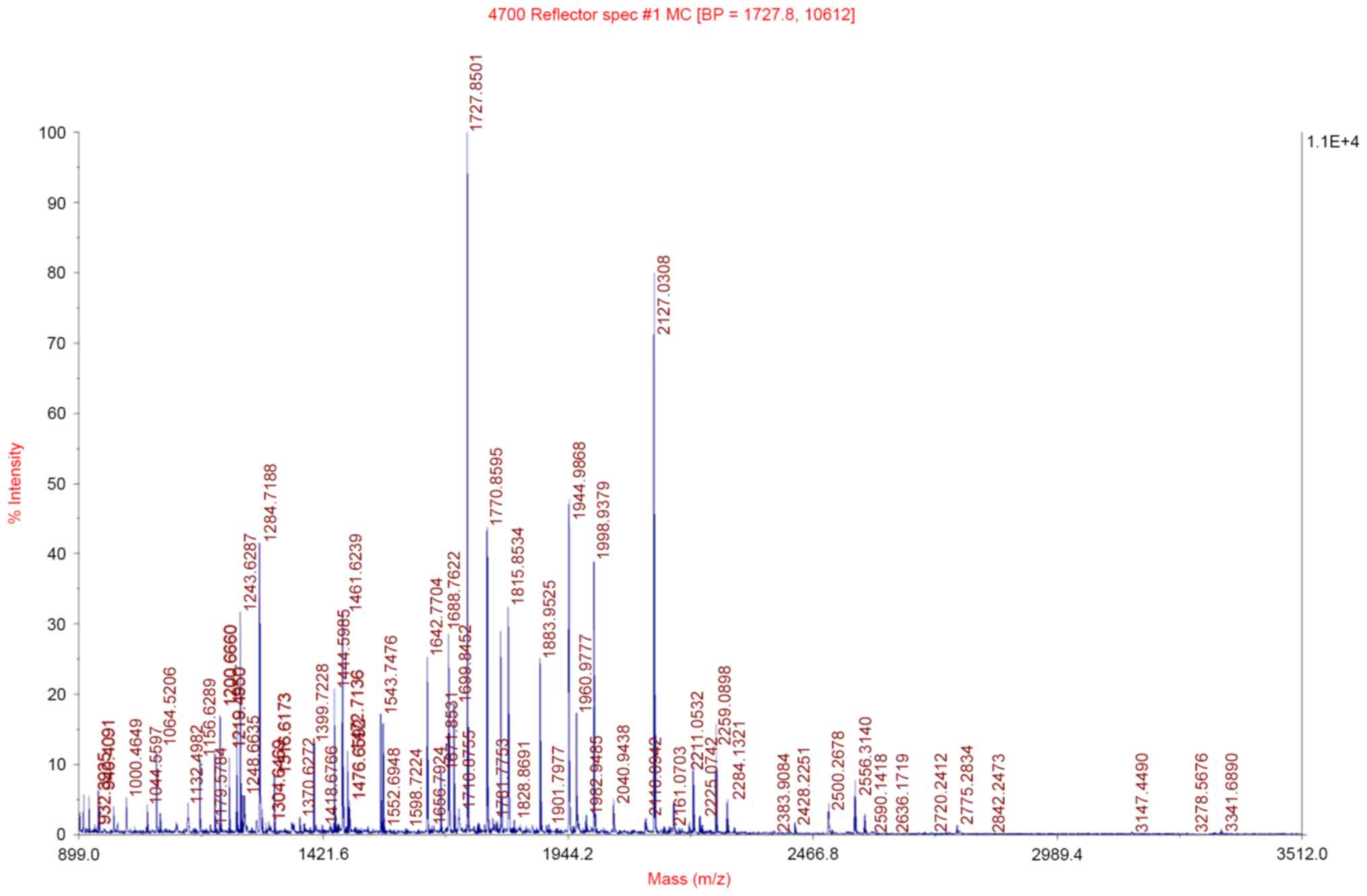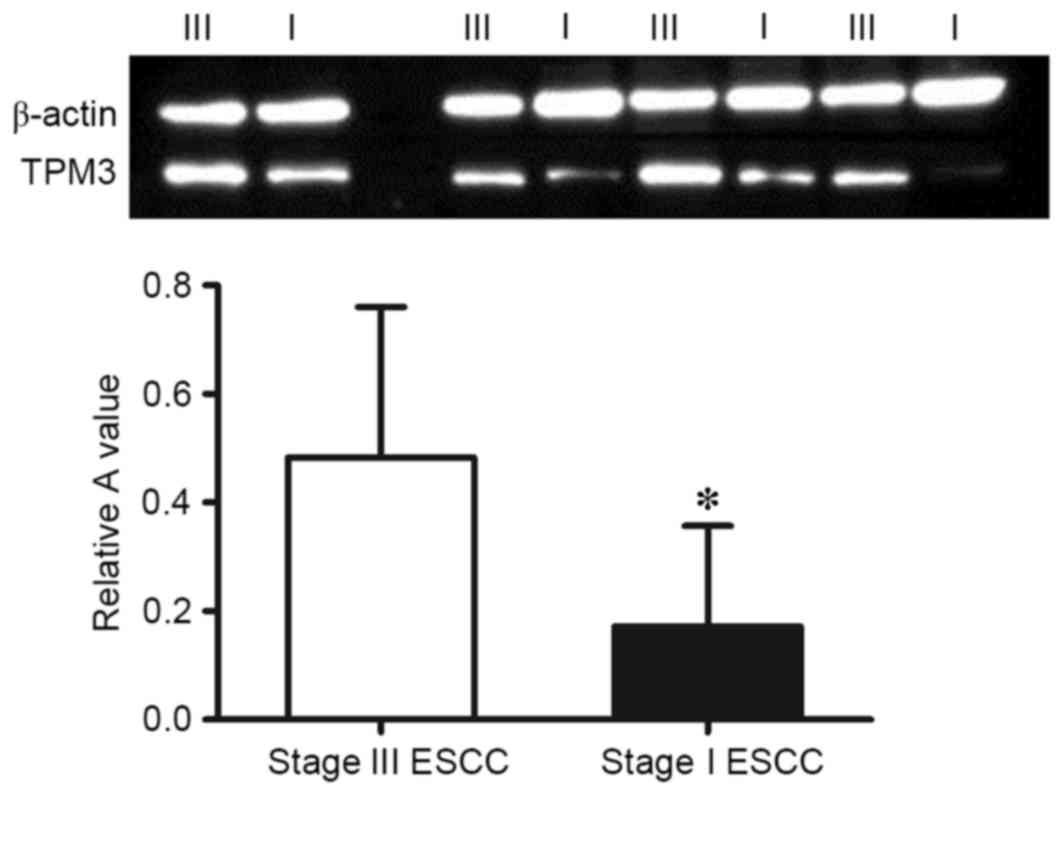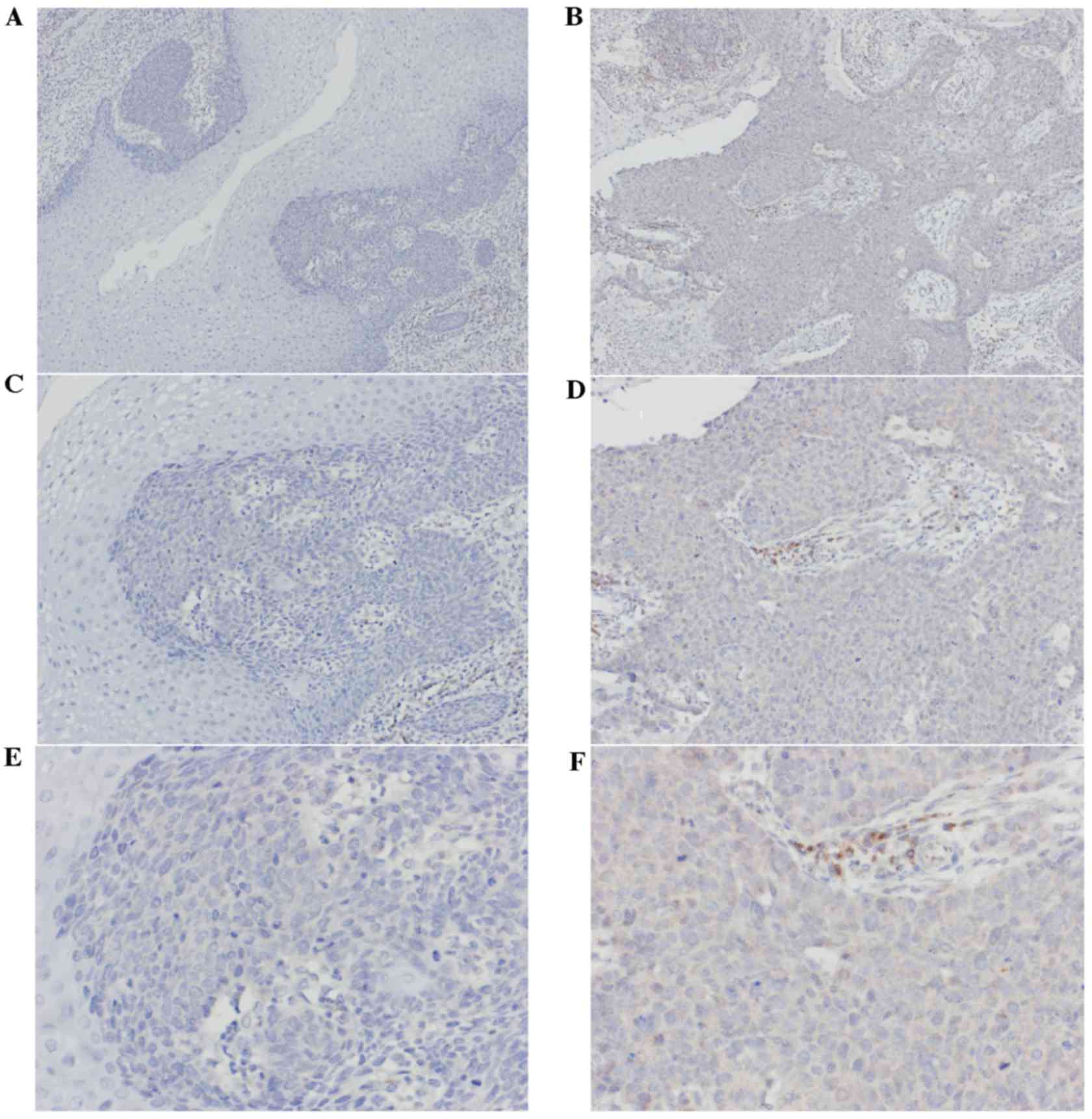Proteomic analysis indicates the importance of TPM3 in esophageal squamous cell carcinoma invasion and metastasis
- Authors:
- Published online on: January 25, 2017 https://doi.org/10.3892/mmr.2017.6145
- Pages: 1236-1242
-
Copyright: © Yu et al. This is an open access article distributed under the terms of Creative Commons Attribution License.
Abstract
Introduction
Esophageal carcinoma is a leading malignancy in China and the sixth leading cause of cancer-associated mortality worldwide (1,2). Esophageal squamous cell carcinoma (ESCC) accounts for 90% of esophageal carcinoma in China (3,4) and ~50% of patients exhibit tumor recurrence following radical resection. Although a number of studies investigating esophageal carcinoma have been conducted, the five-year survival rate of patients with ESCC remains quite low. Invasion and metastasis are key factors in poor prognosis following esophagectomy (5,6). Consequently, ESCC invasion and metastasis-associated molecular biomarkers require investigation in order to improve clinical screening, diagnosis and prognosis.
At present, esophageal carcinoma proteomics research focuses on comparing the expression levels of protein in cancer tissue samples with normal tissue samples to explore its value in the diagnosis of early esophageal carcinoma (7–9). However, there have been few proteomic studies into esophageal cancer invasion and metastasis. In the present study, the protein expression profiles in pathological stage I and stage III ESCC tissue samples were investigated using proteomics technology to screen differentially expressed proteins associated with ESCC invasion and metastasis, which were subsequently verified by immunohistochemistry and western blotting.
Materials and methods
Chemicals
All chemicals were purchased from Sigma-Aldrich; Merck Millipore (Darmstadt, Germany) unless otherwise specified.
Patients and tissue samples
Patients in the present study were diagnosed with ESCC and did not undergo preoperative radiotherapy and chemotherapy, and their tumors were resected in 2008 and 2009 at the Fujian Medical University Union Hospital (Fuzhou, China). Cancerous tissue samples were collected from pathological stage I and III ESCC patients for two-dimensional gel electrophoresis (2-DE) and western blotting. Stage I and III patients were 60.7±10.4 and 62.5±7.7 years of age, respectively. The specimens were collected immediately following surgery, rinsed thoroughly in phosphate-buffered saline (PBS; pH 7.4), snap frozen in liquid nitrogen and maintained at −80°C. This process was completed within 10 min. Tissue samples were collected for immunohistochemistry, including 33 cases of pathological stage I specimens and 33 cases of stage III specimens. All pathological diagnoses were confirmed by two pathologists.
The present study was approved by the Ethics Committee of the Fujian Medical University Union Hospital, and informed consent was obtained from all patients.
Protein extraction and quantification
Protein was extracted from stage I and III ESCC epithelial tissue samples by liquid nitrogen homogenization. 2-DE lysis buffer was added to each tissue sample, which was composed of 7 M urea, 4% CHAPS, 40 mM dithiothreitol (DTT), 2 M thiourea and 1% immobilized pH gradient (IPG) buffer (pH3-11NL). Samples were homogenized for 5 min, and liquid nitrogen was added a number of times to maintain the low temperature. Samples were then removed and placed into 1.5 ml microcentrifuge tubes. Protein concentration in the samples was determined using the 2-D Quant kit (GE Healthcare Life Sciences, Chalfont, UK), according to the manufacturer's protocols. The extraction supernatants were subsequently stored at −80°C.
2-DE and image analysis
Extracted proteins were separated by isoelectrofocusing, which was conducted with an IPGphor-2 instrument (GE Healthcare Life Sciences). A volume of sample equaling 600 µg protein was taken from each sample, and the volume was made up to 450 µl using Destreak Rehydration solution (GE Healthcare Life Sciences), which was subsequently loaded onto the dry strip gel and incubated for 15 h at 20°C for passive rehydration. Following 1-D separation for a total of 96,000 Vh at 20°C (100 V for 4 h, 400 V for 1 h, 1,000 V for 1 h, 2,000 V for 1 h, 4,000 V for 30 min, 8,000 V for 1 h and finally remained at 8,000 V until the value of Vh reached 96,000), strips were sequentially equilibrated with 10 g/l DTT equilibration buffer for 15 min and 25 g/l iodoacetamide buffer (GE Healthcare Life Sciences) for 15 min at room temperature. The 2-D separation was conducted on 1-mm thick 12% sodium dodecyl sulfate-polyacrylamide gel electrophoresis gel (SDS-PAGE), at a power setting of 2 W/gel for the initial 1 h followed by 15 W/gel for 5 h at a temperature of 15°C. Subsequently, the gels were placed into 0.02% Coomassie Brilliant Blue dye R350 and dyed overnight. The gels were eluted with eluent containing methanol, glacial acetic acid and water (1:3:6) and immersed in distilled water for 2 h. Gels were scanned using ImageScanner III (GE Healthcare Life Sciences), and image analysis was performed using ImageMaster 2D Platinum 7.0 software (GE Healthcare Life Sciences). Automatic spot detection and gel matching were conducted. Pairs of 2-DE gels composed of stage I and stage III ESCC gels from matched patients were used and the percentage volume of each spot was estimated and analyzed. Protein spots with >2-fold differences were selected for statistical analysis.
Protein analysis
According to the result of the ImageMaster 2D Platinum 7.0 gel image analysis software, spots from the 2-DE were excised from the gel and placed in 0.5 ml centrifuge tubes. The spots were washed three times by ddH2O. Gel particles were washed with 50 mM NH4HCO3 for 30 min and destained with 50% acetonitrile (twice, 30 min each) in 100 mM NH4HCO3 until all traces of Coomassie Brilliant Blue were removed, and washed with double distilled water again. Gel particles were washed with ultrapure water and then dried under vacuum for 30 min, and rehydrated with the digestion solution (20 µg/µl trypsin in 25 mM NH4HCO3). In order to absorb the trypsin enzyme fully, gel particles were stored at 4°C for 30 min, and then at 37°C overnight. The peptides were extracted with 67% acetonitrile/1% trifluoroacetic acid three times. The extracts were subsequently pooled and dried completely prior to mass spectrum identification.
The samples were mixed (1:1) with a saturated matrix solution (4-hydroxycinnamic acid prepared in 50% acetonitrile/1% trifluoroacetic acid). All mass spectra were obtained on the matrix-assisted laser desorption/ionization-time-of-flight (MALDI-TOF)/mass spectrometry (MS; Applied Biosystems 4800 Proteomics Analyzer; Thermo Fisher Scientific, Inc., Waltham, MA, USA). The MS spectra were acquired in a mass range from 800–4000 Da. The CalMix 5 standard (from the 4800 Proteomics Analyzer calibration mixture; Applied Biosystems; Thermo Fisher Scientific, Inc.) was used to calibrate the instrument. The singly charged peaks were analyzed using an interpretation method where the seven most intense peaks were selected, excluding the trypsin autolysis peaks and the matrix ion signal.
Spectra were analyzed by the Global Protein Server Workstation (version 3.6; GPS; Applied Biosystems; Thermo Fisher Scientific, Inc.). The peptide mass fingerprints and MS/MS data were searched by Mascot version 2.1 software (Matrix Science, Ltd., London, UK). Searches were preformed against the National Center for Biotechnology Information database with the following parameter settings: Trypsin cleavage, one missed cleavage allowed; 50 ppm mass accuracy; and 0.25 Da MS/MS accuracy. Identification with a GPS confidence index ≥95% was considered acceptable.
Western blotting
Total proteins were extracted from 100 mg stage I and stage III ESCC tissues and quantified using the Bradford assay according to the manufacturer's protocols. Proteins were separated by 12% SDS-PAGE and transferred onto polyvinylidene fluoride membranes (EMD Millipore, Billerica, MA, USA). The membranes were blocked in 0.5% bovine serum albumin (BSA) for 2 h at room temperature. After washing with PBS three times, the membranes were incubated with primary antibodies overnight at 4°C. The primary antibodies were monoclonal mouse anti-human tropomyosin 3 (TPM3) antibody (dilution, 1:1,000; cat. no. ab113692; Abcam, Cambridge, UK) or anti-β-actin antibody (dilution, 1:1,500; cat. no. ab8226; Abcam). Following washing with PBS three times, membranes were incubated with horseradish peroxidase-conjugated goat anti-mouse IgG secondary antibody (dilution, 1:1,500; cat. no. ab6728, Abcam) for 1 h at room temperature. The signals were detected using the BeyoECL Plus enhanced chemiluminescence kit (cat. no. P0018; Beyotime Institute of Biotechnology, Haimen, China) and ImageQuant LAS 4000mini (GE Healthcare Life Sciences). The results were analyzed using ImageJ software (National Institutes of Health, Bethesda, MD, USA).
Immunohistochemistry (IHC) staining and assessment
IHC staining was performed on 5-mm thick sections from paraffin-embedded specimens using Histostain®-Plus kits (Invitrogen; Thermo Fisher Scientific, Inc.). The slides with paraffin sections were deparaffinized with xylene and rehydrated in a graded series of ethanol. For antigen retrieval, the slides were heated in a microwave for 10 min in citrate buffer solution (pH 6) and washed in PBS. Subsequently, the slides were incubated with monoclonal mouse anti-human TPM3 antibody (dilution, 1:150; cat. no. ab113692; Abcam) and BSA for 30 min at room temperature. Slides were gently washed in PBS three times followed by incubation with secondary antibody [dilution, 1:200; cat. no. KIT-5910; MaxVision (Shanghai) Ltd., Shanghai, China] for 15 min at room temperature. Slides were rinsed with PBS again, and the color was developed by diaminobenzidine [MaxVision (Shanghai) Ltd.]. As a negative staining control, the primary antibody was replaced with PBS.
Slides were observed by light microscopy (Olympus Corporation, Tokyo, Japan). The results were independently evaluated by two pathologists who were blinded to the clinicopathological information. A semiquantitative scoring method was used in which staining intensity and the proportion of cells stained were considered. The values of staining intensity were evaluated (0, no staining; 1, weak staining; 2, moderate staining; or 3, strong staining), and the values of percentage of cells stained were assessed (0, <1%; 1, 1–25%; 2, 26–50%; 3, 51–75%; or 4, >75%). The two scores were multiplied and divided into two grades, negative (score, 0–4), and positive (score, 5–12).
Statistical analysis
All data were analyzed with SPSS 19.0 (SPSS IBM, Armonk, NY, USA). Fisher's exact tests were used to compare differences between continuous variables. Categorical variables were compared using Pearson's χ2 tests. P<0.05 was considered to indicate a statistically significant difference.
Results
2-DE and image analysis
2-DE gels of stage I ESCC tissues were compared with their corresponding matched stage III ESCC tissues. Protein spots were detected according to the different protein expression patterns of specimens and the similarity of the protein expression spectrum. A total of 821±28 protein spots with 80.3% matching ratio were observed in protein maps of stage I ESCC tissues, and 853±31 spots with 82.5% matching ratio were identified in protein maps of stage III ESCC tissues. In addition, fifteen protein spots with >2-fold differences were observed between stage I ESCC tissues and stage III ESCC tissues (Fig. 1).
Mass spectrometric analysis
These fifteen protein spots with >2-fold difference were then excised, in-gel digested and analyzed with a MALDI-TOF/MS. The observed peptide mass spectra were analyzed by peptide mass fingerprinting, and 12 differentially expressed proteins were identified (listed in Table I). These proteins are closely associated with ESCC invasion and metastasis, apoptosis and cell signal transduction. The peptide mass fingerprinting of TPM3 is presented in Fig. 2.
Table I.Characteristics of identified differential expressed proteins in stage III ESCC tissue samples compared with stage I samples. |
Western blot analysis
The protein expression levels of TPM3 in stage I and stage III ESCC tissues were analyzed using western blotting. As presented in Fig. 3, the expression of TPM3 in stage III ESCC tissues was significantly higher than in stage I ESCC tissues (P=0.009) which was consistent with the results of the proteomic analysis.
IHC
The expression levels of TPM3 protein in the 33 stage I specimens and 33 stage III specimens were observed using immunohistochemical staining. Cytoplasm staining was considered as positive. The levels of staining depended on the expression of TPM3 and the rate of positive cells (Fig. 4). The immunohistochemical results indicated the expression levels of TPM3 in stage III ESCC tissues were significantly higher than in stage I ESCC tissues (P=0.005; Table II).
Table II.Clinical data and TPM3 expression in stage I and III ESCC patients by immunohistochemistry. |
Discussion
Previous studies have demonstrated that expression changes of genes and proteins are associated with tumor progression (6,10–13). The mutant genes are transcribed and translated into proteins, and the expression levels of proteins dictate the tumor phenotype and regulate its biological behavior. Thus, proteomics can reflect the features of tumor biology more effectively than genomics (8). Using the proteomics method, Uemura et al (11) demonstrated the high expression of transglutaminase 3 (TGM3) was associated with ESCC lymph node metastasis and detecting the expression of TGM3 may provide a novel strategy for preventing the recurrence of ESCC. Fan et al (14) performed a proteomic analysis and suggested that TP-α, collagen type VI α-1 chain and S100 calcium-binding protein A9 may be important in the development of ESCC (14).
ESCC tumor-node-metastasis (TNM) staging is associated with the biological behavior of tumor cells and reflects the degree of tumor malignancy. At present, proteins associated with ESCC TNM staging have not been determined. The differential expressed proteins were compared between stage I ESCC tissues and stage III ESCC tissues in the present study using 2-DE and MS. Twelve differentially expressed proteins were identified including TPM3, isoform 3 of interleukin-1 receptor antagonist protein (IL1RN), myosin regulatory light chain 12B RLC (MYL12B), heterogeneous nuclear ribonucleoprotein F (hnRNP F), albumin, desmin (DES), cystatin-A (CSTA), RPSA 30 kDa protein, involucrin, isoform 1 of proapoptotic caspase adapter protein (MGC29506), vimentin, tropomyosin 2 (TPM2), and heat shock protein β-1. These differentially expressed proteins may be involved in ESCC invasion and metastasis, apoptosis and cell signal transduction.
Previous studies have demonstrated the identified differentially expressed proteins are important role in the development of tumors. IL1RN promoted Helicobacter pylori infection in the stomach and increased the risk of the formation of non-cardia gastric cancer (15,16). Cytoskeleton rearrangement altered the activity of colon cancer cells, which was associated with MYL12B (17). Su et al (18) observed that the overexpression of hnRNP F influenced the development of colon tumors and interfered with normal apoptosis and energy metabolism of bladder cells, which could result in bladder cancer. DES, TPM3, TPM2 and vimentin are important in maintaining the stability of the cytoskeleton, and changes in vimentin expression were associated with liver cancer metastasis and recurrence (19). A previous study indicated that smoking and chronic obstructive pulmonary disease promoted respiratory tract squamous carcinoma by upregulating CSTA expression levels (20). Downregulation of involucrin participated in the development of squamous carcinomas via influencing epithelial-mesenchymal transition (EMT) (21). MGC29506 promoted the progress of gastric cancer via altering the cell cycle (22). Chen et al (23) reported that decreasing HSPB1 expression was associated with the low differentiation of ESCC (23).
Choi et al (24) demonstrated the overexpression of TPM3 altered liver cancer cell invasion and metastasis via influencing EMT. Using 2-DE and MS, the present study observed the expression levels of TPM3 in stage III ESCC tissues were significantly higher than stage I. Thus, the effects of TPM3 on ESCC invasion and metastasis were further investigated in the current study.
TPM3 encodes an actin-binding protein, which is a member of the tropomyosin family. In skeletal muscle, TPM3 meditates the reaction of myosin and actin with Ca2+ ions and stabilizes the microfilament cytoskeleton of muscle cells (25). However, the functions of TPM3 protein in non-muscle cells require further elucidation. Previous studies have demonstrated that TPM3 contributes to tumorigenesis in the thyroid papillary carcinoma and chronic eosinophilic granulocyte leukemia by fusing with neurotrophic receptor tyrosine kinase 1 and Platelet-derived growth factor receptor β, respectively (26,27). The results of the western blotting and IHC in the present study demonstrated that the protein expression levels of TPM3 in stage III ESCC tissues were significantly higher compared with stage I. Thus, the present study hypothesized that the high expression levels of TPM3 may be associated with the invasion and metastasis of ESCC while the molecular mechanism remains to be elucidated. Gene transfection and RNA interference technology will be applied in further research. TPM3 plasmids will be constructed and stably transfected in human ESCC cells in order to observe the influence of changes in TPM3 gene expression on ESCC cell proliferation, apoptosis, cell-cycle distribution and invasion ability.
In conclusion, a total of 12 differentially expressed proteins were identified in the present study. All of these proteins were closely associated with ESCC invasion and metastasis, apoptosis and cell signal transduction. The overexpression of TPM3 in stage III ESCC tissues was also verified, which may be important in ESCC invasion and metastasis. The present study helped to investigate the mechanism underlying the influence of differentially expressed proteins on ESCC invasion and metastasis, and search the markers associated with ESCC diagnosis, which may optimize patient treatment strategies.
Acknowledgements
The present study was supported by the Fujian Medical Innovation Fund (2014-CX-15), Fujian Young Teacher Fund (JAT160209), Fujian Medical University Professor Fund (JS12008) and Fujian Province Science and Technology Programmed Fund (2012Y0030).
References
|
Pennathur A, Gibson MK, Jobe BA and Luketich JD: Oesophageal carcinoma. Lancet. 381:400–412. 2013. View Article : Google Scholar : PubMed/NCBI | |
|
Jia Y, Wang N, Wang J, Tian H, Ma W, Wang K, Tan B, Zhang G, Yang S, Bai B and Cheng Y: Down-regulation of stromal caveolin-1 expression in esophageal squamous cell carcinoma: A potent predictor of lymph node metastases, early tumor recurrence, and poor prognosis. Ann Surg Oncol. 21:329–336. 2014. View Article : Google Scholar : PubMed/NCBI | |
|
Wang K, Ma W, Wang J, Yu L, Zhang X, Wang Z, Tan B, Wang N, Bai B, Yang S, et al: Tumor-stroma ratio is an independent predictor for survival in esophageal squamous cell carcinoma. J Thorac Oncol. 7:1457–1461. 2012. View Article : Google Scholar : PubMed/NCBI | |
|
Zhu YH, Liu H, Zhang LY, Zeng T, Song Y, Qin YR, Li L, Liu L, Li J, Zhang B and Guan XY: Downregulation of LGI1 promotes tumor metastasis in esophageal squamous cell carcinoma. Carcinogenesis. 35:1154–1161. 2014. View Article : Google Scholar : PubMed/NCBI | |
|
Xuan X, Li Q, Zhang Z, Du Y and Liu P: Increased expression levels of S100A4 associated with hypoxia-induced invasion and metastasis in esophageal squamous cell cancer. Tumour Biol. 35:12535–12543. 2014. View Article : Google Scholar : PubMed/NCBI | |
|
Hu Y, Correa AM, Hoque A, Guan B, Ye F, Huang J, Swisher SG, Wu TT, Ajani JA and Xu XC: Prognostic significance of differentially expressed miRNAs in esophageal cancer. Int J Cancer. 128:132–143. 2011. View Article : Google Scholar : PubMed/NCBI | |
|
Kashyap MK, Harsha HC, Renuse S, Pawar H, Sahasrabuddhe NA, Kim MS, Marimuthu A, Keerthikumar S, Muthusamy B, Kandasamy K, et al: SILAC-based quantitative proteomic approach to identify potential biomarkers from the esophageal squamous cell carcinoma secretome. Cancer Biol Ther. 10:796–810. 2010. View Article : Google Scholar : PubMed/NCBI | |
|
Liu Z, Feng JG, Tuersun A, Liu T, Liu H, Liu Q, Zheng ST, Huang CG, Lv GD, Sheyhidin I and Lu XM: Proteomic identification of differentially-expressed proteins in esophageal cancer in three ethnic groups in Xinjiang. Mol Biol Rep. 38:3261–3269. 2011. View Article : Google Scholar : PubMed/NCBI | |
|
Zhang J, Wang K, Zhang J, Liu SS, Dai L and Zhang JY: Using proteomic approach to identify tumor-associated proteins as biomarkers in human esophageal squamous cell carcinoma. J Proteome Res. 10:2863–2872. 2011. View Article : Google Scholar : PubMed/NCBI | |
|
Ying J, Shan L, Li J, Zhong L, Xue L, Zhao H, Li L, Langford C, Guo L, Qiu T, et al: Genome-wide screening for genetic alterations in esophageal cancer by aCGH identifies 11q13 amplification oncogenes associated with nodal metastasis. PLoS one. 7:e397972012. View Article : Google Scholar : PubMed/NCBI | |
|
Uemura N, Nakanishi Y, Kato H, Saito S, Nagino M, Hirohashi S and Kondo T: Transglutaminase 3 as a prognostic biomarker in esophageal cancer revealed by proteomics. Int J Cancer. 124:2106–2115. 2009. View Article : Google Scholar : PubMed/NCBI | |
|
Yang Z, Guan B, Men T, Fujimoto J and Xu X: Comparable molecular alterations in 4-nitroquinoline 1-oxide-induced oral and esophageal cancer in mice and in human esophageal cancer, associated with poor prognosis of patients. In vivo. 27:473–484. 2013.PubMed/NCBI | |
|
Moghanibashi M, Jazii FR, Soheili ZS, Zare M, Karkhane A, Parivar K and Mohamadynejad P: Proteomics of a new esophageal cancer cell line established from Persian patient. Gene. 500:124–133. 2012. View Article : Google Scholar : PubMed/NCBI | |
|
Fan NJ, Gao CF, Wang CS, Zhao G, Lv JJ, Wang XL, Chu GH, Yin J, Li DH, Chen X, et al: Identification of the up-regulation of TP-alpha, collagen alpha-1(VI) chain and S100A9 in esophageal squamous cell carcinoma by a proteomic method. J Proteomics. 75:3977–3986. 2012. View Article : Google Scholar : PubMed/NCBI | |
|
da Costa DM, Neves-Filho EH, Alves MK and Rabenhorst SH: Interleukin polymorphisms and differential methylation status in gastric cancer: An association with Helicobacter pylori infection. Epigenomics. 5:167–175. 2013. View Article : Google Scholar : PubMed/NCBI | |
|
Xue H, Lin B, Ni P, Xu H and Huang G: Interleukin-1B and interleukin-1 RN polymorphisms and gastric carcinoma risk: A meta-analysis. J Gastroenterol Hepatol. 25:1604–1617. 2010. View Article : Google Scholar : PubMed/NCBI | |
|
Dabrowska M, Skoneczny M and Rode W: Functional gene expression profile underlying methotrexate-induced senescence in human colon cancer cells. Tumor Biol. 32:965–976. 2011. View Article : Google Scholar | |
|
Su CC, Su JH, Lin JJ, Chen CC, Hwang WI, Huang HH and Wu YJ: An investigation into the cytotoxic effects of 13-acetoxysarcocrassolide from the soft coral Sarcophyton crassocaule on bladder cancer cells. Mar Drugs. 9:2622–2642. 2011. View Article : Google Scholar : PubMed/NCBI | |
|
Dong P, He XW, Gu J, Wu WG, Li ML, Yang JH, Zhang L, Ding QC, Lu JH, Mu JS, et al: Vimentin significantly promoted gallbladder carcinoma metastasis. Chin Med J (Engl). 124:4236–4244. 2011.PubMed/NCBI | |
|
Butler MW, Fukui T, Salit J, Shaykhiev R, Mezey JG, Hackett NR and Crystal RG: Modulation of cystatin A expression in human airway epithelium related to genotype, smoking, COPD, and lung cancer. Cancer Res. 71:2572–2581. 2011. View Article : Google Scholar : PubMed/NCBI | |
|
Lan YJ, Chen H, Chen JQ, Lei QH, Zheng M and Shao ZR: Immunolocalization of vimentin, keratin 17, Ki-67, Involucrin, β-catenin and E-cadherin in cutaneous squamous cell carcinoma. Pathol Oncol Res. 20:263–266. 2014. View Article : Google Scholar : PubMed/NCBI | |
|
Xia L, Shen C, Fu Y, Tian L and Chen M: MGC29506 induces cell cycle arrest and is downregulated in gastric cancer. Cell Immunol. 281:31–36. 2013. View Article : Google Scholar : PubMed/NCBI | |
|
Chen JH, Chen LM, Xu LY, Wu MY and Shen ZY: Expression and significance of heat shock proteins in esophageal squamous cell carcinoma. Zhonghua zhong liu za zhi. 28:758–761. 2006.(In Chinese). PubMed/NCBI | |
|
Choi HS, Yim SH, Xu HD, Jung SH, Shin SH, Hu HJ, Jung CK, Choi JY and Chung YJ: Tropomyosin3 overexpression and a potential link to epithelial-mesenchymal transition in human hepatocellular carcinoma. BMC cancer. 10:1222010. View Article : Google Scholar : PubMed/NCBI | |
|
Pieples K, Arteaga G, Solaro RJ, Grupp I, Lorenz JN, Boivin GP, Jagatheesan G, Labitzke E, DeTombe PP, Konhilas JP, et al: Tropomyosin 3 expression leads to hypercontractility and attenuates myofilament length-dependent Ca(2+) activation. Am J Physiol Heart Circ Physio. 283:H1344–H1353. 2002. View Article : Google Scholar | |
|
Greco A, Miranda C and Pierotti MA: Rearrangements of NTRK1 gene in papillary thyroid carcinoma. Mol Cell Endocrinol. 321:44–49. 2010. View Article : Google Scholar : PubMed/NCBI | |
|
Li Z, Yang R, Zhao J, Yuan R, Lu Q, Li Q and Tse W: Molecular diagnosis and targeted therapy of a pediatric chronic eosinophilic leukemia patient carrying TPM3-PDGFRB fusion. Pediatr Blood Cancer. 56:463–466. 2011. View Article : Google Scholar : PubMed/NCBI |













